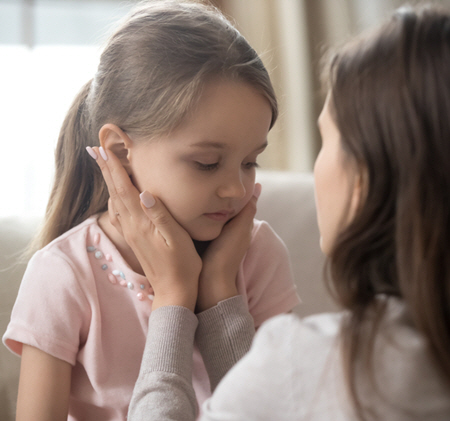 We have an innate desire to protect and teach our children…
We have an innate desire to protect and teach our children…
But sometimes, life throws them a curveball, and we don’t know how to respond, support them, or even understand how it affects them.
Have you been concerned about your child lately?
Perhaps they are showing new negative behaviors like defiance, arguing, or destructiveness.
Or maybe they’ve withdrawn, don’t want to talk about what’s bothering them, or have a generally negative attitude.
Has your child recently been through a life transition?
A family move…
A new job impacting the family schedule…
Changing schools…
A new baby sibling…
Divorce…
The dynamics of a blended family…
There are so many “typical” life experiences that are part of adulthood. But it can be different for children. These experiences can threaten their sense of safety, stability, and security.
And because they don’t have the skills to navigate them, they often develop a protective guard, remaining on alert for other situations that might challenge their basic needs.
Has your child experienced or witnessed a difficult situation?
If they have, they’re probably struggling to process what happened.
Perhaps your child has been abused and you don’t know where to start to help them through this difficult time. You might be having a hard time learning about it, too.
Trauma and adverse life experiences are an unfortunate part of most of our lives. We are all unique, including our children, and how a person responds to these experiences can be unpredictable.
But that doesn’t mean there aren’t ways to help children work through it. We just have to speak their language.
 So… how do you figure out what your children need?
So… how do you figure out what your children need?
Children and adults learn, interact, and express themselves differently.
For children, the world is their playground. They want to observe, explore, engage, test, problem-solve, and learn.
A child’s prefrontal cortex (basically behind your forehead, where rational, logical thinking occurs) is not fully developed. Children don’t have the cognitive ability to process information rationally and logically, and they lack the vocabulary to express certain emotions, thoughts, experiences, or physical sensations in a way we can fully understand.
Instead, children express themselves through their behaviors and play. This play also helps their brain process new information and experiences by creating memory networks. These memory networks constantly develop, change, and link similar emotions, thoughts, and physical sensations with new experiences.
That’s why play is so critical to a child’s development.
Play is the natural way to engage a child in therapy.
I guess that seems obvious now!
During play, children express themselves, reenact experiences, and use objects to communicate internal experiences they do not have the vocabulary to explain.
There are a variety of types of play. Children may explore new items to learn how they work, engage in role-play, connect to others or play independently, or they may use different materials in creative ways.
Whatever they do as they play, children are using their imagination to express themselves in ways their words cannot.
Depending on your child’s age, development, and personality, the types of play engaged in during therapy will vary. Some children need time to adapt and feel safe in a new environment. They may take several sessions, exploring the playroom quietly as they find what interests them.
Some children quickly adjust to the playroom and develop rapport easily with their therapist. Others might take a little more time, but most children naturally engage or invite the therapist into their play once they are comfortable.
 Let’s talk about the playroom…
Let’s talk about the playroom…
Children’s behaviors and interests vary greatly, so I have lots of options. I make sure they have an outlet to explore and share their experiences, concerns, worries, fears, or sadness.
They can use different games, toys, role-plays, stuffed animals, books, Legos, art, or a sand tray to process, learn, and express themselves.
They might use multiple objects in the playroom during session, test boundaries within the playroom, or ask questions about things they notice or are not familiar with. As your child’s therapist, I will observe their play and use their behaviors, communication, and personality to determine which play modalities suit them best.
If your child has experienced something traumatic…
When children have negative experiences, life transitions, or external stressors like neglect, abuse, or other trauma, it changes their brain and memory networks. This can result in emotional or behavioral problems.
Children must be able to process these experiences in ways that offer them support and understanding, and that usually requires professional help.
A well-researched technique for desensitizing children to these negative memories is a therapy called Eye Movement Desensitization Reprocessing (EMDR). I offer EMDR to children whose behavior or emotions have changed after long-term exposure to stressors, difficult life experiences, or trauma. With children, EMDR will be conducted in the playroom while the child plays.
If you would like to learn more about EMDR, you can read all about it by visiting the “My Approaches” tab above.
 Here’s where you fit into this as the parent…
Here’s where you fit into this as the parent…
As the parent, it will be important to support your child between sessions. This may include reflecting their emotions as they begin to learn and label them, providing patience as they work through difficult behavioral changes, or setting boundaries to reinforce skills learned during sessions.
For some children, their behavior might worsen before getting better. I’d like you to consider how hard it is to change a behavior you don’t like about yourself or develop a new habit. As an adult, you can logically process reasons for making a change, staying focused on your desire to improve or your overall goals.
But children lack that kind of vision and control. They might not understand why they’re being asked to change… or not have the skills to change even if they do. As a result, they might push boundaries to gain understanding and test limits. If you understand this, you’re better able to support and encourage your child through difficult changes, adjustments, and emotions.
In addition, your input, experiences, knowledge, and questions regarding your child’s progress and treatment are often the basis for treatment planning and goal-setting.
You are the expert on your child, even if you feel you don’t know what to do or how to help them.
As part of your child’s treatment, you may be asked to participate in play during a session… or your child may want to show you something they created or achieved… or you might join in a family session (sometimes with siblings).
We’ll also have sessions together (without your child) to discuss their progress, share my observations, and get feedback from you about their functioning outside of the playroom. Parent sessions may also be used to explore parenting techniques, reward systems, and how you can use therapeutic interventions at home with your child.
I am also available to you outside of sessions when updates, changes, or concerns arise that will help me with your child in our next session.
 I know you probably feel like you’ve tried everything…
I know you probably feel like you’ve tried everything…
And you probably don’t know what to do next. But you’re doing it now. You’re here because you want what’s best for them, and you’re in the right place.
Working with children is one of my favorite parts of being a therapist. Watching your child be resilient and thrive despite their challenges is a blessing to be a part of. It would be my honor to work with you and your child.
I’m a parent myself, so I know you still have questions about me and what your child will be doing in therapy. That’s why I offer a free 15-minute consultation to discuss your concerns, answer questions, and ensure your family and I will be a good fit to work together.
Choose this next best step for your child. Call me today: (770) 371-2332.


